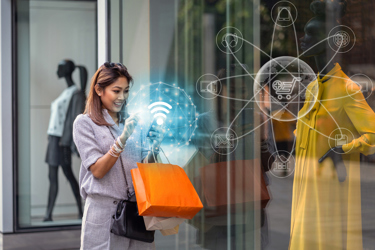The Growth In Physical And Digital Shopping Means Retailers Must Deliver Omnichannel Excellence – Here's How
By Ush Shukla, Solace

After an industrywide shift to digital channels, the post-lockdown bounce back of physical shopping has left the barriers of digital vs. physical well and truly blurred. Never before has an omni-channel shopping experience been so important. Forward-thinking retailers must tackle the change head-on, using event-driven architecture to deliver real-time products and services, any place, any time, or via any channel. The importance of event-driven architecture to deliver true omni-channel excellence has reached new heights – it will put customers at the center of every transaction.
For retailers, the shift to digital was well underway before the global pandemic. Now, the landscape has changed yet again and traditional bricks and mortars have taken back control – in 2021, bricks and mortar sales grew faster than e-Commerce. Never before has the need for omni-channel been so important to retailers.
It’s about achieving omni-channel excellence through unified, consistent, and real-time experiences regardless of location and channel.
Retailers Fight Back
According to a 2021 Global Retail Industry Digital Transformation study by Fujitsu, retailers are already investing in better understanding and serving their customers. Priority investments include combining their online and physical presence; monitoring customer traffic flow and predicting movement; enhancing the customer experience; and recommending and marketing products and services.
Navigating Uncertainty With 360° Visibility
Another study found that 44% of retailers are chiefly concerned with how lack of real-time data can lead to decisions made on inconsistent or outdated information. Further, 65% recognized the benefits of real-time data for their business operations. To succeed, retailers must unify data from all channels that may be scattered across point of sale, eCommerce, ERP, and other systems.
Many retailers are also hindered from delivering exceptional customer experiences and truly omni-channel services because of legacy systems, poor integration of ad-hoc applications, and delayed or inaccurate notification of significant data events that have occurred. Without integrating all the disparate data and making it available to other applications in real time, it’s almost impossible to deliver a fully connected omni-channel customer experience.
Introducing Event-Driven Architecture – The Key To Real-Time Business Operations
A seamless retail experience must cross employees, suppliers, and customers. Remember, they all do something different with the data and therefore require a different software architecture paradigm approach to moving data. Enter event-driven architecture (EDA). Every retail transaction creates data, such as the product purchased, price, and customer name. Software developers call that transaction an “event”.
Real-time streaming of these events across an organization is a fundamental tenet to omni-channel success – ensuring the continuous processing of real-time data directly as it is produced. Real-time event streaming must connect event “brokers” – essentially hardware, software, or SaaS technology used to transmit information between the applications that create the events (producers), and those that receive the events (consumers). Most often, brokers use a publish-subscribe pattern to achieve this.
In retail terms, this could apply to stores, IoT applications, eCommerce platforms, warehouses, and HQ – regardless of the system, cloud or protocols involved. The result is a business-wide web of event brokers – or “event mesh” – that is dynamic, open, simple, and available everywhere.
Looking To The Next Big Thing: The Meta-Driven Future Of Retail
Looking further forward, EDA and real-time event streaming will have a huge role to underpin the meta-driven future of retail – where the digital and physical worlds increasingly combine in new and exciting ways.
Imagine retailers in remote and disconnected locations being able to “store forward” inventory data, or those with perishable goods, using IoT-enabled heat lamps that link expiration data to an analytics engine, to notify stores the moment food should be removed from the shelf.
Then we have the power of push notifications. By linking location data with customer behavior, stores could send real-time push notifications to customers using their retail apps, if at some point the customer walks past a store that contains stock for the item, they previously left behind in their cart online.
It is evident from these and other common retail scenarios that EDA serves as the necessary digital backbone for improved omni-channel experiences, helping retailers realize significant cost savings, optimize supply chain efficiencies, and strengthen customer loyalties – all of which lead to greater revenue and profitability.
EDA: Separating The Forward-Thinkers From The Digital Laggards
Event streaming and event management, underpinned by an IT infrastructure built on the paradigm of event-driven architecture, are the emerging technologies powering real-time event-driven businesses that can build omni-channel retail excellence.
About The Author
Ush Shukla is a Distinguished Engineer at Solace. As an Enterprise Integration Architect, Ush has more than 13 years of experience leading diverse teams in the implementation of large-scale middleware solutions across varied business domains.
